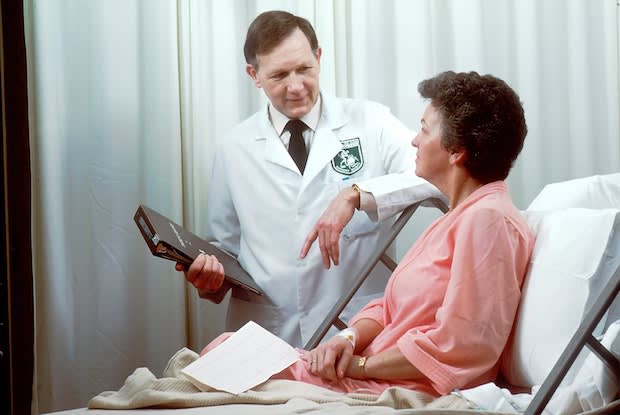Table of Contents
I. Estrogen and Progesterone Overview
Estrogen and Progesterone Overview
The health of the female reproductive system relies on the ovaries’ production of two hormones—estrogen and progesterone. These two hormones are vital for the development of female sex characteristics during puberty and fertility when a woman enters childbearing age.
There are three major types of estrogen that the ovaries produce, including estradiol, estrone, and estriol. During puberty, estradiol is responsible for the development of the breasts and reproductive organs, along with the fat distribution in the legs, hips, and breasts. Progesterone is necessary to prepare the body for pregnancy. Both estrogen and progesterone are necessary for healthy menstruation. [1]
When a woman goes through menopause, estrogen and progesterone fluctuations are likely to occur. Fluctuations of these hormones can cause several symptoms and increase the risk for health complications like ovarian cysts and osteoporosis (bone loss). Common menopause symptoms include hot flashes and mood swings.
To treat hormonal fluctuations and imbalances, doctors may recommend hormone replacement therapy (HRT) to adjust the body’s hormone levels. HRT can be implemented with Climara patches or Estraderm patches applied to the skin or through Prometrium (progesterone)oral capsules. HRT has long been a trusted way of treating menopause symptoms, but new research has cited certain risks that may be involved with these medications. Read on to learn about the different types of HRT and any associated risks. Hormone therapy can be performed to supplement estrogen levels, progesterone levels, or both hormones simultaneously. There are five types of estrogen replacement therapy (ERT), progesterone replacement therapy (PRT), and combined ERT-PRT treatments. Your doctor will take your health into consideration to determine which of the following is best suited for your symptoms: Oral route HRT: Oral medication for progesterone and estrogen are the most common type of treatment method. Oral HRT pills are typically taken without food, once daily. Different pills may have different dosing schedules, so always follow your doctor’s dosage directions. [2] Skin patches: Another common way of boosting estrogen and progesterone is through skin patches. Estraderm patches or Climara patches may be more convenient to take than oral tablets. Unlike oral tablets, skin patches do not increase your risk of blood clots or indigestion. [3] HRT gels: Gels are similar to patches in terms of convenience. They also do not increase your risk of blood clots. Estrogen-only HRT gels can increase womb cancer risk in women who still have their womb unless progesterone is taken separately. [3] Implants: This treatment method involves inserting small implants under the skin. Implants gradually release hormones and can last for several months between replacements. Womb cancer is a potential risk of estrogen-only implants unless progesterone is taken separately. [3] Vaginal route: HRT can be done using a pessary (vaginal prosthetic device), ring, or cream applied to the inside of the vagina. This method does not increase breast cancer risk. Vaginal HRT is used to treat vaginal dryness and may not help with other menopause symptoms like hot flushes. [3] Hormone replacement therapy can increase the risk of several types of cancer. Studies report that women who are treated with ERT-PRT may have more advanced colorectal tumors at the time of detection. Follow-up studies showed that CRC risk reduction disappeared after participants were taken off ERT-PRT. [4] In women who have lung cancer, taking ERT-PRT has been shown to increase the risk of death compared to women with lung cancer who took the placebo. However, in women who were treated with ERT alone, no increases in the risk of death were observed. [4] A long-term study showed that estrogen replacement therapy alone could lower breast cancer risk when compared to women who took a placebo. After a decade of follow-ups, women who took estrogen alone still had a lower risk of breast cancer. However, women who combined estrogen and progesterone in their therapy were found to be more at risk of breast cancer than the placebo group. In women who took combined treatments, the breast cancers were also larger and likelier to spread to lymph nodes. This risk decreased when hormone therapy was stopped. [4] All combinations of HRT can increase the risk of heart attack, stroke, and blood clots. The good news is that the risk for these vascular conditions returned to normal levels after stopping hormone therapy. [5] By taking estrogen or estrogen combined with progesterone, you may increase your risk of developing the following conditions: The estrogen and progesterone used in hormone therapy come from plants, animals, or a laboratory. As a result, the chemical structures in these hormones will not be identical to the hormones naturally produced by your body. Be wary of non-FDA-approved hormone products that claim to be identical to the body’s hormones. These claims are not supported by credible scientific evidence. It is safer to fill your prescription for estradiol patches or progesterone tablets from a certified pharmacy. Before starting any form of hormone replacement therapy, talk to your doctor. [4] The content in this article is intended for informational purposes only. This website does not provide medical advice. In all circumstances, you should always seek the advice of your physician and/or other qualified health professionals(s) for drug, medical condition, or treatment advice. The content provided on this website is not a substitute for professional medical advice, diagnosis, or treatment.
Types of Hormone Therapy

Cancers Linked to ERT

HRT-Related Conditions
